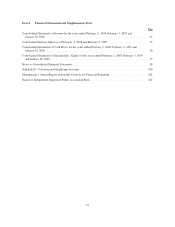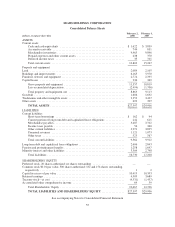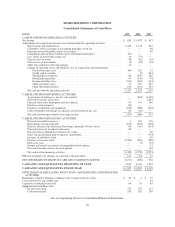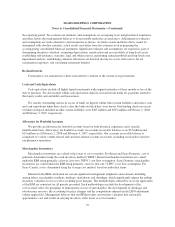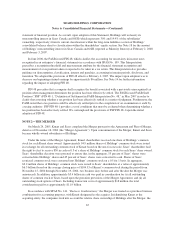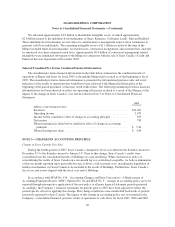Sears 2007 Annual Report Download - page 60
Download and view the complete annual report
Please find page 60 of the 2007 Sears annual report below. You can navigate through the pages in the report by either clicking on the pages listed below, or by using the keyword search tool below to find specific information within the annual report.SEARS HOLDINGS CORPORATION
Notes to Consolidated Financial Statements—(Continued)
Approximately 53% of consolidated merchandise inventories are valued using LIFO. To estimate the effects
of inflation on inventories, we utilize external price indices determined by an outside source, the Bureau of Labor
Statistics. If the FIFO method of inventory valuation had been used instead of the LIFO method, merchandise
inventories would have been $22 million higher at February 2, 2008 and $29 million higher at February 3, 2007.
Effective January 27, 2005, we changed our method of accounting for certain indirect buying, warehousing
and distribution costs. See Note 3 for further discussion of this change in accounting principle.
Vendor Rebates and Allowances
We receive rebates and allowances from certain vendors through a variety of programs and arrangements
intended to offset our costs of promoting and selling certain vendor products. These vendor payments are
recorded as a reduction to the cost of merchandise inventories when earned and, thereafter, as a reduction of cost
of sales, buying and occupancy as the merchandise is sold. Up-front consideration received from vendors linked
to purchases or other commitments is initially deferred and amortized ratably to cost of sales, buying and
occupancy over the life of the contract or as performance of the activities specified by the vendor to earn the fee
is completed.
Property and Equipment
Property and equipment are recorded at cost, less accumulated depreciation. Additions and substantial
improvements are capitalized and include expenditures that materially extend the useful lives of existing
facilities and equipment. Maintenance and repairs that do not materially improve or extend the lives of the
respective assets are expensed as incurred.
Depreciation expense, which includes depreciation on assets under capital leases, is recorded over the
estimated useful lives of the respective assets using the straight-line method for financial statement purposes, and
accelerated methods for tax purposes. The range of lives are generally 20 to 50 years for buildings, 3 to 10 years
for furniture, fixtures and equipment, and 3 to 5 years for computer systems and computer equipment. Leasehold
improvements are depreciated over the shorter of the associated lease term or the estimated useful life of the
asset.
Impairment of Long-Lived Assets and Costs Associated with Exit Activities
In accordance with Statement of Financial Accounting Standards (“SFAS”) No. 144, “Accounting for the
Impairment or Disposal of Long-lived Assets,” the carrying value of long-lived assets, including property and
equipment, is evaluated whenever events or changes in circumstances indicate that a potential impairment has
occurred relative to a given asset or assets. Factors that could result in an impairment review include, but are not
limited to, a current period cash flow loss combined with a history of cash flow losses or a projection that
demonstrates continuing losses associated with the use of a long-lived asset, significant changes in the manner of
use of the assets or significant changes in business strategies. An impairment loss is recognized when the
estimated undiscounted cash flows expected to result from the use of the asset plus net proceeds expected from
disposition of the asset (if any) are less than the carrying value of the asset. When an impairment loss is
recognized, the carrying amount of the asset is reduced to its estimated fair value as determined based on quoted
market prices or through the use of other valuation techniques. In addition to our on-going monitoring of
potential impairment circumstances which may arise, we perform an impairment analysis on our long-lived
assets as of the last day of our November accounting period each year.
60





